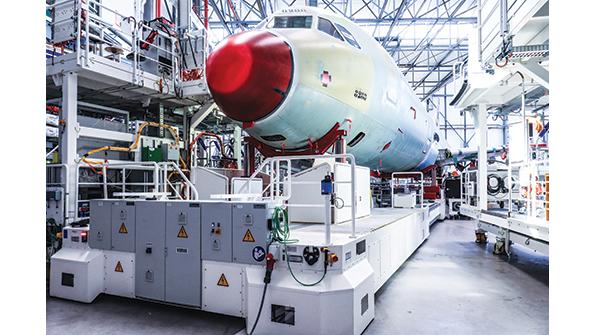オピニオン:今後さらに旅客機の減産が必要に | The Case For More Aircraft Production Cuts

3月に新型コロナウィルスの感染拡大が民間航空業界を大混乱に陥れて以来、航空機の生産量がいつ「通常通り」に戻るのかについて、多くの議論がなされてきた。大手企業のCEO達は2019年を「通常」と定義しており、これが業界の共通認識となっている。しかし、以前の市場予測や生産計画をよく見てみると、2019年は基準としてふさわしくなかったことが分かる。
昨年の一般常識は、エアバス社とボーイング社はともに生産量をこれまで以上に引き上げるだろうというものだったが、両社はすでに市場が吸収しきれないほどの機数を生産しており、しかも将来的にさらに増産を進める予定だった。ここで、ひとつ計算してみよう。
2019年にエアバス社は、今後20年で座席数100席以上の旅客機には39,000機の需要があると予測した。これは年平均で1,970機となり、ボーイング社の予測値ともほぼ一致する。両社でシェアを半分ずつ占めると、それぞれ年間985機ずつの需要を抱えることになる。ところが、この数値はすでに大きすぎる。なぜなら、この中ではブラジルのエンブラエル社、中国の中国商用飛機(Comac)、ロシアの統一航空機製造会社(United Aircraft社)のシェアが考慮されていないからだ。さらにいえば、他の会社が破壊的イノベーションにより、電気ハイブリッド式の100席級旅客機を今後数十年の内に開発することもあるだろう。
エアバス社は2019年に863機をデリバリーしており、これは先に挙げた20年予測の年間平均に近い数字だ。ボーイング社も860機を生産・デリバリーする予定だったため、合計すると約1,840機となる。もっとも、ボーイング社は737MAX飛行停止に伴い、最終的には380機しかデリバリーできなかった。しかし、ここでのポイントは、両社は今後20年の需要予測の年間平均にあたる機数をすでに生産しようとしていたということだ。言い換えれば、航空史上最悪の不況の前の段階で、もはや増産の余地は残されていなかったということだ。他の航空機メーカーの存在を考慮すると、特にナローボディ機についてはかなりの過剰生産が行われていたと考えることができる。
もちろん、コロナ危機の影響でこれらの調査や生産計画はすべて無意味になってしまった。しかし、業界はコロナ危機以前の計画がすでに非現実的なものであったことを認識する必要がある。原因がなんであれ、その計画は失敗する運命にあったのだ。それはコロナ危機のような激しいものではなかったかもしれないが、壮大な夢が実現するはずがなかったのである。
誰もが納得する事例を挙げると、過剰生産の兆候はコロナ危機の最中にも見えていた。エアバス社は生産量を3分の1にカットしただけで、なるべく多く維持しようとした。ボーイング社も、保管中の737MAXを早期に引渡し、同時に新規生産を再開したいと考えている。そのためには、航空会社は明らかに不必要かつ支払いも困難な機材の受け取りを強いられることになるかもしれない。実際、エアバス社は顧客未定のホワイトテール機を多数生産しているが、これは過去に避けると約束していたはずのことだ。
今や、高い生産量を維持することは近視眼的といえる。これは財務的に苦しい状況に陥っている航空会社に対して、さらに圧力を強めることに他ならない。将来的に新造機のデリバリーを受けられるようになったときの価格設定にも悪影響を及ぼすだろう。なぜなら、リース会社は多くの機材を抱えており、ほぼ新造機と呼べるような機材を格安でも処分したいと考えているオペレーターも多数存在し、これらと競合することになるからだ。
もちろん、急な減産はサプライチェーンを破壊する可能性があることはいうまでもない。しかし、コロナ危機以前にはサプライチェーンの一部で急な増産に追いつけない部分もあったが、今やそれも過剰な供給体制になってしまったというのが辛い現実だ。そして、この過剰供給はこの先何年も続くことは明白である。
経営陣として被害を最小限に抑えたいことは理解でき、この数ヶ月間で雪崩のように襲いかかってきた悪い知らせの数々を分析する時間も必要になるだろう。そして、少ないデリバリー・少ない収益・小さくなるシェアがもたらす、財務的な負担やマーケットからの圧力がかかっていることも明らかだ。ボーイング社は737MAXの生産中断と顧客からの失望感により、コロナ危機以前から大きなダメージを負っており、今後さらにシェアを失う要素にも事欠かない。
さらに悪いことに、より厳しい決断も迫られている。ボーイング社にとっては、737MAXの生産再開ペースが遅くなることはもちろん、777Xの就航にも極めて長い時間を要するだろう。エアバス社もナローボディ機のさらなる減産が必要だ。長距離路線の需要がすぐに回復しない場合(回復の兆候はまったく見られない)、A350やA330neoの生産量も厳しい再検討を迫られることになり、これも大きなダメージにつながるだろう。
需要が回復したとき、以前の計画が非現実的なものだったことを思い出すことは極めて重要だ。今回はより慎重なアプローチが必要になる-その逆をしたくなる強い欲求とは裏腹に。
以上は、Jens Flottauが Aviation Week & Space Technologyいた記事です。Aviation Week Intelligence Network (AWIN) のメンバーシップにご登録いただくと、開発プログラムやフリートの情報、会社や連絡先データベースへのアクセスが可能になり、新たなビジネスの発見やマーケット動向を把握することができます。貴社向けにカスタマイズされた製品デモをリクエスト。
Since the COVID-19 pandemic waylaid commercial aviation in March, there has been much talk about when aircraft production volumes will return to “normal.” Across the industry, leading CEOs have defined “normal” as 2019. But a closer look at earlier market forecasts and planned production rates shows that 2019 is the wrong benchmark.
Although conventional wisdom last year was that Airbus and Boeing would raise output ever higher, the two aircraft manufacturers already were producing more airplanes than the market could absorb and were planning to build significantly more in the future. Let’s do the math.
In 2019, Airbus projected demand for 39,000 aircraft of 100 seats or more over the next 20 years—an average of 1,970 annually and a figure roughly in line with Boeing’s forecast. If the two companies split the market 50-50, each would have demand for 985 aircraft a year. But that number already is too high because it does not take into account sales by Brazil’s Embraer, China’s Comac or Russia’s United Aircraft Corp. It is also possible that another company, perhaps a market disruptor, could build the first hybrid-electric 100-seater in the next couple of decades.
Airbus delivered 863 aircraft in 2019, reasonably close to its allocation of the forecast 20-year average; Boeing planned to build and hand over about 860 jets last year, for a combined total of approximately 1,840 aircraft. Boeing ultimately delivered just 380 units because of the 737 MAX grounding, but the point is that both companies were planning to build nearly as many aircraft as their average forecast for the next 20 years. In other words, even before the biggest downturn in aviation history, no room for any production growth existed. Take the other aircraft manufacturers into account, and you could surmise there already was significant overproduction, particularly in the narrowbody segment.
Of course, the fallout from the novel coronavirus pandemic has made all these studies and production plans irrelevant. But industry needs to realize its pre-COVID-19 plans were already unrealistic. One way or another, it had to go wrong, maybe not as dramatically as it turned out, but there was no way the dreams could have become reality.
To no one’s surprise, the signs of overproduction have been visible during the crisis. Airbus cut output by only one-third, aiming to keep as high a level as possible. Boeing wants to hand over the undelivered stored MAXs and ramp up production of new ones at the same time. Essentially, airlines may be forced to accept aircraft they clearly do not want and cannot afford. Airbus is already producing a significant number of white tails, something it had promised to avoid.
Keeping production high now is short-sighted. It weakens airline customers further during a time of huge financial pressure. It is also bad for future pricing once airlines are ready to take more aircraft. There will be ample capacity from lessors or cheap, almost brand-new aircraft that operators want to dispose of.
Arguably, steep cuts in production could ruin the supply chain. But the bitter truth is that although some parts of the supply chain were struggling to keep up with the tempo before the crisis, there is now far too much capacity. And clearly, an excess of capacity will continue for years.
Management understandably wants to minimize the damage and needs time to digest the avalanche of bad news over the past few months. The financial and market pressures are also obvious: the fewer deliveries, the less revenue and the smaller the market share. Boeing, already badly damaged by the MAX production interruption and that aircraft’s disappointing reception by customers, has every incentive to contain any further loss of market share.
Nonetheless, more tough decisions loom. On the Boeing side, a slower reintroduction of the MAX is inevitable, as is a very slow service-entry process for the 777X. Airbus will have to cut narrowbody output further. If long-haul travel does not return quickly—and no indications suggest it will—Airbus will also have to take another hard look at A350 and A330neo rates, as painful as that may be.
Remembering that earlier plans were unrealistic will be particularly important once demand recovers. A more measured approach is needed this time despite competitive incentives to do the opposite.